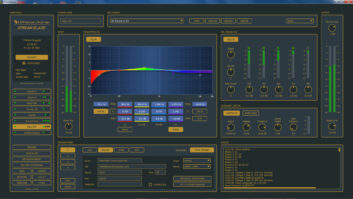(click thumbnail)In the Delaware Valley, an Iconic Noncom Station Gets a New Home
It would be hard for a visitor to Philadelphia to miss the new studios of WXPN(FM), the award-winning AAA non-commercial station licensed to the University of Pennsylvania. Large neon signs on the top and side of the historic Hajoca Building on Walnut Street are visible to 65,000 daily drivers on the Schuylkill Expressway and thousands of pedestrians and bikers around the West Philadelphia Penn campus.
Before the radio station moved into its new home late last year, it operated from two locations, with studios in an old house on Spruce Street and administrative offices on Chestnut Street. Technical Director Jay Goldman headed up the engineering design of the move and new facility. Also involved were Engineer Jared Styles, Studio Recording Engineer Chris Williams and IT Administrator Jonny Meister.
The station, which came to the FM dial in the 1950s and has carrier-current roots back to 1945, is a prominent part of the Philadelphia mediascape, and is the home of the public radio program “World Café.” WXPN’s programming is also carried regionally via translators in Harrisburg and the Lehigh Valley of Pennsylvania, as well as the Baltimore area to the south.
The new center houses five control rooms and three studios. Logitek Numix consoles are standard; the station uses RCS Master Control Version XV for live assist, with storage capacity of 140 GB, as well as Selector for scheduling.
Digital
(click thumbnail)WXPN and ‘World Café’ host David Dye is seen through a studio window. Photo by Scott Fybush
Most of the plant is digital. “We have a Broadcast Tools SS 8.1 8 X 1 audio switcher in the transmission path. This allows us to switch any control room or the automation system directly into the STL,” Goldman said. “This switcher, the TFT EAS switch and Aphex Compellor are analog. Everything else is digital.”
Although most of XPN’s broadcast day is automated live assist, three Denon 961-Fs are available in every room for new music that is not yet in the system. For rarities on vinyl, Technics SP-15 turntables are in place. The interconnect infrastructure between studios and to the technical operations center is via Radio Systems Studio Hub+.
Asked his experience using that Cat-5 wiring system, Goldman said, “This is not a paid commercial announcement, but I love it. One bonus I discovered is that I’m able to run audio around the building, outside of the technical core area, to desktops, etc. for auditioning of offline editing purposes, using the Ethernet infrastructure.”
(Radio Systems President Dan Braverman was equally complimentary: “WXPN is the radio station I listen to all day long. I would have been so jealous if any one else got to do this build. There is no other facility in the country like WXPN and ‘World Café Live.'”)
In the news studio, a Logitek Remora console, 360 Systems Instant Replay and AP audio wire service terminal allow the newscaster to engineer his or her own newscast without assistance from the on-air host.
Key Contractors• Systems Integrator: Radio Systems
• Studio Furniture: Studio Technology
• Electrical: Tritech Systems
• Architect: Meyers Associates
Source and Recording Gear:
• Denon DN 961-FA CD Players
• 360 Systems Instant Replay
• Tascam MX 2424 Hard-Disk Recorders
• Electro-Voice RE-20 Mics
• Neumann TLM 104, KM 84 Mics
• AKG 414 Mics
• Sennheiser SM 81 Mics
Consoles:
• Logitek Numix, Remora, ROC 10
• Yamaha PM-1D, 02R
Studio Software:
• RCS Master Control Automation
• RCS Selector Scheduling
• SAW 32 Editing
Infrastructure:
• Radio Systems Studio Hub+
Master Clock System
• Radio Systems
While much of the facility is new, the station brought over a Logitek Audio Engine, ROC 10 and Remora 4 worksurfaces from the old facility, as well as Yamaha 02R digital mixer, 360 Systems Shortcut and Denon CD players.
The naming of the new studios reflect the station’s musical roots. Rather than A, B and C, the studio signs read John, Paul, George, Ringo, Elvis and Dylan.
Network technology is leveraged for smooth workflow and efficiency. Laser printers in the studios enable the programming staff to create logs at their desks and print them out in the studios without having to leave the office. IP-based Webcams are planned in the building’s entertainment venue, enabling recording engineers on the other side of the building to see the action during a session, and creates an opportunity for live feeds over the Internet.
After the station feed leaves the studios, “We run multimode fiber across campus using FIBOX equipment to the roof of a 26-story high-rise student residence building,” Goldman said. “From there we have a 950 MHz Harris CD Link for the five-mile hop to the antenna farm in the Roxborough section of the city.”
Member-supported
The 2-1/2 year renovation of a historic former plumbing warehouse, also owned by the university, was made possible by a capital campaign project which has raised almost $4 million. Close to 80 percent of contributions have come from individual members. WXPN began operations in the new building in September of 2004. The renovation project’s cost has been estmated by the university at $15 million.
Systems integration was done by Radio Systems, while Studio Technology provided furniture and Tritech Systems completed the generator and electrical installations. Documentation was created with Microsoft Visio and Excel.
In the lower level of the building is a technical operations center, which houses the shop, telephone and network patch panels, and equipment racks that hold automation gear, file servers, satellite demods, transmission and monitoring equipment.
The operations center also houses the servers for WXPN’s 24 kbps streaming audio feeds: one a Mac-friendly MP3 stream via SHOUTcast, the other in Windows Media Format. During periods when the station is playing entire CDs, a violation of RIAA restrictions on streaming media, a switcher selects an audio feed from a CD jukebox containing station-owned recordings.
The facilities are also home of the “World Café,” a daily program highlighting singer-songwriters and distributed via Public Radio International. At the heart of the “World Café” complex is a 900-square-foot performance studio, providing enough space for large bands and live audiences. Soundproof windows enable the public to view recording sessions from the lower-level lobby. Two control rooms adjoin the performance studio, the larger containing a Yamaha PM 1D recording console, Tascam MX-2424 hard-disk recorders and vintage UREI LA-4 limiters. A Yamaha 02-R and Logitek console are housed in the smaller control room.
Green rooms are available for visiting artists, who often travel through the night before making an appearance.
Live entertainment
WXPN’s facilities are co-located in the 40,000-square-foot building along with World Café Live, an independently owned, for-profit entity that features a 350-seat theatre and 100-seat restaurant/live performance stage. Mic lines are split and run to both the sound stage mixer and to WXPN, enabling the station to do independent recording and mixdowns from both venues.
The co-location with the entertainment venue has been hailed by organizers as an innovative partnership between a for-profit enterprise and a not-for-profit public station as well as part of the university’s efforts to develop and revitalize part of campus. Station officials have said that by having studios located with a separate but related venue “means we’ll have a physical place where XPN members, our on-air talent and staff, and musical artists can come together as one community.” The studios and World Café Live are financed and managed separately.
As with most post-9/11 designs, emergency preparedness and security were considerations. WXPN’s studio facilities can be powered from a 60 KW ETS generator; the racks in the operations center are equipped with uninterruptible power supplies. Card key access points are located throughout the station, and television monitors connected to DirectTV are visible in every studio.
While the facility is designed for efficient operations, aesthetics are not forgotten. A large mural entitled “Sphere Music” by Paul Santoleri of the Philadelphia Mural Arts Program decorates the Walnut Street lobby, while the “Tower of Babble,” also by Santoleri, is painted on the lower level hallway. Much of the World Cafe Live and WXPN operations are visible to pedestrians via large windows at street level.
While the station has moved into a 21st-century facility, the history of WXPN is not forgotten. Display cases throughout the building contain analog artifacts such as carts, vinyl LPs and reel tape boxes. There is also a display of T-shirts and coffee mugs with old station logos and slogans. A poster in the conference room contains photos of architectural details from the 1850s mansion that was the previous home of WXPN.
Tom Vernon was an engineer at WXPN from 1994-99. For historical information about WXPN, including its move to its previous home, see www.archives.upenn.edu/faids/upf/upf10.html.














